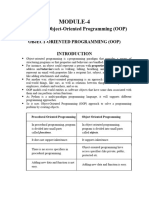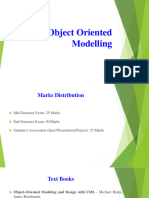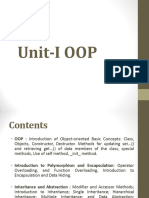Year 1 Computer Programming - Lecture 6
Uploaded by
thecheeseman66666Year 1 Computer Programming - Lecture 6
Uploaded by
thecheeseman66666CMP CMP4266
Computer Programming UG1
Lecture – 6
(Based on Gaddis, T., Starting out with Python 3e, Pearson Education)
CMP4266, School of CS & DT, Birmingham City University.
Next – The coding challenge
You will be given 48 hours to complete coding tasks on
Moodle.
This is based on the Labs 1,2,3,4,5 and 6, so to do well in the
coding challenge you need to complete all previous labs.
It should be submitted within 48 hours, else, typical penalties
for late submission will be applied.
After completing the challenge, you need to complete a
verification process with your personal tutor which includes:
– Making sure labs 1, 2, 3, 4, 5 and 6 have been submitted
– Explain your code to your personal tutor
When the coding challenge is on, no tutor or a demonstrator will give
you any help or support in relation to the challenge or any relevant lab
exercises.
CMP4266, School of CS & DT, Birmingham City University.
Outline
Procedural and Object-Oriented Programming
Classes
Designing Classes in UML
Class Definition & Class Instance
CMP4266, School of CS & DT, Birmingham City University.
Procedural Programming
Procedural programming: writing programs made of functions
that perform specific tasks
– Procedures typically operate on data items that are separate from the
procedures
– Data items commonly passed from one procedure to another
– Focus: to create procedures that operate on the program’s data
CMP4266, School of CS & DT, Birmingham City University.
Object-Oriented Programming
Object-oriented programming: focused on creating objects
Object:
– In reality: a tangible thing that we may touch, feel and manipulate
– In software development: a model of a tangible thing that contains
- data: to represent different characteristics of the tangible thing
- associate behaviors (procedures): to manipulate the data of the tangible
thing.
CMP4266, School of CS & DT, Birmingham City University.
Object-Oriented Programming? Why?
Data Types in Python :
– Float
– String
– Integer
Good when used for procedural operation e.g.
Value = 3.2 * 5
But how can a variable hold all data needed to represent a Customer,
Student or Bank Account.
Using variables ?? E.g.
Customer = “ email address = customer@info.uk, address, city, Gender,
Credit card number, bank details, shopping basket, purchased items, ……etc.”
Student = [first name, last name, modules, degree, address, bank details, etc.]
CMP4266, School of CS & DT, Birmingham City University.
Procedural vs Object-Oriented Programming
Find the area and perimeter of a thin rectangular plate
Passing data when
procedures are called
No need to pass data when
procedures are called on objects
CMP4266, School of CS & DT, Birmingham City University.
Object Oriented Programming – No restriction
In OOP, everything is object.
Objects are anything that you can give a noun too.
Eg. TV, Lamp and glass of water.
In reality objects are designed with the clear purpose, but
they are not limited in the way they can interact with one
another.
For example,
– The lamp is used to provide sufficient light for reading a
book
– Use the glass of water to drink
– Dump the water on the book
Interactions between the world’s objects are limited with
our imagination rather than the object limitations.
CMP4266, School of CS & DT, Birmingham City University.
Object Oriented Programming
Object-oriented programming is
centered on creating objects rather Object
than procedures.
Attributes (data)
Objects are a melding of data and
procedures that manipulate that
data.
Data in an object are known as
attributes.
Procedures in an object are known
as methods. Methods
(behaviors / procedures)
CMP4266, School of CS & DT, Birmingham City University.
Object Oriented Programming
Object-oriented programming
combines data and behavior
via encapsulation. Object
Data hiding is the ability of an Programming Attributes (data)
Interface typically private to this object
object to hide data from other
objects in the program.
Only an objects methods
should be able to directly
manipulate its attributes.
Other objects are allowed
manipulate an object’s Other
attributes via the object’s objects
methods.
This indirect access is known
as a programming interface.
Methods
(behaviors / procedures)
CMP4266, School of CS & DT, Birmingham City University.
Object-Oriented Programming
Data attributes: define the state of an object
– Example: clock object would have second, minute, and hour data
attributes
Public methods: allow external code to manipulate the object
– Example: set_time, set_alarm_time
Private methods: used for object’s inner workings
def clock_inner_operation():
for hours in range(24):
for minutes in range(60):
for seconds in range(60):
print(hours, ':', minutes, ':', seconds)
CMP4266, School of CS & DT, Birmingham City University.
Classes
Class: code that specifies the data attributes and methods of a
particular type of object
– Similar to a blueprint of a house or a cookie cutter
Instance: an object created according to a class definition
– Similar to a specific house built according to the blueprint or a specific
cookie
– There can be many instances of one class
CMP4266, School of CS & DT, Birmingham City University.
Object Oriented Design and Programming
Object Oriented Design
– Is a systematic process to think about how software systems are
composed of interacting objects
- identify the objects
- Identify attributes and methods of each object
- How the objects are connected to each other
– Output of object oriented design is an implementation specification
Object Oriented Programming
– Is the process of converting the implementation specification into a working
program
CMP4266, School of CS & DT, Birmingham City University.
Object Oriented Design Specification
Unified Modelling Language (UML) is a very popular language that is used
to specify object oriented design.
– It offers different types of diagrams to specify OOD.
– Classes (i.e. objects) of a software system and the relationships among the classes can
be described using UML class diagram
In UML classes are represented as a box with three sections
– Top section displays the name of the class
– Middle section lists the data attributes
– Bottom section lists the methods of the class
– A minus (-) sign in front of an attribute (or method) signifies private attribute (or method)
– A plus (+) sign in front of an attribute (or method) signifies a public attribute (or method)
– Simple relation (known as association) between two classes is represented by solid lines
CMP4266, School of CS & DT, Birmingham City University.
Object Oriented Design Specification
When developing object oriented program, first goal is to identify
classes
– Typically involves identifying the real-world objects that are in the
problem
– Technique for identifying classes:
A customer uses a bank ATM to check balance
- Get written description of the problem domain
of his/her bank account,
- Identify all nouns in the description, each of which is a potential class
deposit funds,
- Refine the list to withdraw
include only cash
classesand/or
that are transfer
relevant to funds
the problem
To find out a class’s responsibilities look at the problem domain. A
classes responsibilities are:
– The things the class is responsible for knowing
- Identifying these helps identify the class’s data attributes
– The actions the class is responsible for doing
- Identifying these helps identify the class’s methods
CMP4266, School of CS & DT, Birmingham City University.
Object Oriented Design Specification (Example)
Consider a Banking System.
– The most obvious objects would be i) Bank Account and ii) Customer
– Each customer should be connected to a bank account
– Identify attributes and methods for each object
CMP4266, School of CS & DT, Birmingham City University.
Class Definitions in Python
Class definition: set of statements that define a class’s methods and data
attributes
– Format: begin with class Class_name:
- Class names often start with uppercase letter
– Method definition like any other python function definition
- self parameter: required in every method in the class – references
the specific object that the method is working on
Initializer method: automatically executed when an instance of the class is
created
– Initializes object’s data attributes and assigns self parameter to the
object that was just created
– Format: def __init__ (self):
Class methods can have multiple parameters in addition to self
CMP4266, School of CS & DT, Birmingham City University.
Class Definitions (Example)
CMP4266, School of CS & DT, Birmingham City University.
Class Instance
Classes can be stored in modules
– Filename for module must end in .py
– Module can be imported to programs that use the class
To create a new instance of a class call the initializer method
– Format: My_instance = Class_Name()
To call any of the class methods using the created instance,
use dot notation
– Format: My_instance.method()
– Because the self parameter references the specific instance of the
object, the method will affect this instance
- Reference to self is passed automatically
CMP4266, School of CS & DT, Birmingham City University.
Class Instance (Example)
CMP4266, School of CS & DT, Birmingham City University.
Class Definitions
Object’s state: the values of the object’s attribute at a given
moment
__str__ method: displays the object’s state
– Automatically called when the object is passed as an argument to the
print function
– Automatically called when the object is passed as an argument to the
str function
Instance attribute: belongs to a specific instance of a class
– Created when a method uses the self parameter to create an attribute
If many instances of a class are created, each would have its
own set of attributes
CMP4266, School of CS & DT, Birmingham City University.
Accessor and Mutator Methods
An object’s data attributes should be private
– To make sure of this, place two underscores (__) in front of attribute
name
- Example: __current_minute
Typically, all of a class’s data attributes are private and provide
methods to access and change them
Accessor methods: return a value from a class’s attribute
without changing it
– Safe way for code outside the class to retrieve the value of attributes
Mutator methods: store or change the value of a data attribute
CMP4266, School of CS & DT, Birmingham City University.
Class Example
CMP4266, School of CS & DT, Birmingham City University.
Implementing Association (1)
For a banking system, we have
– BankAccount and Customer objects
– Each customer should be connected to a bank account
How to implement this?
• Association is generally implemented by making one object as attribute of the
other object.
CMP4266, School of CS & DT, Birmingham City University.
Implementing Association (2)
CMP4266, School of CS & DT, Birmingham City University.
Implementing Association (3)
CMP4266, School of CS & DT, Birmingham City University.
Implementing Association (4)
CMP4266, School of CS & DT, Birmingham City University.
6.1 Exercise: Identify the class, its attributes and
methods from a scenario (15 - 20 minutes)
In-class
Exercise
Create a software that can calculate energy consumption
and running cost of home appliances.
To create an object, you need to pass 3 arguments through
its __init__ method, and to be stored as the class attributes,
and these are appliance name, power consumption in
watts, the number of hours the device is being used per
day.
The class should have the following methods;
print appliance details
Calculate energy consumption per month in kWh;
Calclate monthly running cost.
– Note, you need to provide this method with electricity rate per kWh
to calculate the running cost. E.g. £0.10 per kWh
CMP4266 , School of CS & DT, Birmingham City University.
Exercise 6.1: Identify the class, its attributes and
methods from a scenario (continued)
In-class
Notes: Exercise
• To calculate the energy consumption of the appliance per month
in kWh use the formula ((Watts * hours)/1000)*30
• To calculate the running cost per month ( in kWh) you should use
the formula (electricity rate * energy consumption).
Example:
A refrigerator consumes 300 watts and is used for 24
hours per day, and the energy cost is £0.10 per kWh. To
calculate its running cost per month you need to do the
following:
Monthly consumption (kWh) = ((300*24)/1000) * 30
Monthly cost (£)= Monthly consumption (kWh) * £0.10
From above the refrigerator cost £21.60 per month.
CMP4266 , School of CS & DT, Birmingham City University.
You might also like
- Entel - RAID Integrator Training - Day 1 InstallationNo ratings yetEntel - RAID Integrator Training - Day 1 Installation59 pages
- Object Oriented Programming OOP (Autosaved)No ratings yetObject Oriented Programming OOP (Autosaved)51 pages
- Topic B Classes and Objects v1-9!3!2022No ratings yetTopic B Classes and Objects v1-9!3!202297 pages
- Year 1 Computer Programming - Lecture 1No ratings yetYear 1 Computer Programming - Lecture 135 pages
- Object_Oriented_Programming_Chapter_One_Introduction_New_2018No ratings yetObject_Oriented_Programming_Chapter_One_Introduction_New_201849 pages
- OOPS-Fall-2024-Lecture-01-OOPIntro-pptxNo ratings yetOOPS-Fall-2024-Lecture-01-OOPIntro-pptx67 pages
- Introduction To C++ AND Object Oriented Programming: ObjectivesNo ratings yetIntroduction To C++ AND Object Oriented Programming: Objectives18 pages
- Chapter-3.1 (Basics of Object Oriented Programming)No ratings yetChapter-3.1 (Basics of Object Oriented Programming)27 pages
- Introduction To Object Oriented ProgrammingNo ratings yetIntroduction To Object Oriented Programming9 pages
- Object Oriented Programming Methodology Using Java: Prof: Deepak Gaikar (Computer Department) RGIT-MumbaiNo ratings yetObject Oriented Programming Methodology Using Java: Prof: Deepak Gaikar (Computer Department) RGIT-Mumbai73 pages
- Chapter 2 System Analusis and ModellingNo ratings yetChapter 2 System Analusis and Modelling167 pages
- CSC241: Object Oriented Programming: Lecture No 01No ratings yetCSC241: Object Oriented Programming: Lecture No 0141 pages
- Section 1 Object Oriented Analysis and Design Lab: Structure Page NosNo ratings yetSection 1 Object Oriented Analysis and Design Lab: Structure Page Nos27 pages
- DCIT 201 Programming I: Session 1 - Fundamental Concepts of OOD and OOPNo ratings yetDCIT 201 Programming I: Session 1 - Fundamental Concepts of OOD and OOP35 pages
- Chapter 10 Review and Programming ExercisesNo ratings yetChapter 10 Review and Programming Exercises8 pages
- Lecture 8 - Object Oriented ProgrammingNo ratings yetLecture 8 - Object Oriented Programming20 pages
- Object Oriented Analysis and Design Class NotesNo ratings yetObject Oriented Analysis and Design Class Notes72 pages
- Artificial Intelligence Lab Manual: PythonNo ratings yetArtificial Intelligence Lab Manual: Python15 pages
- Feedback - Quiz 2a: You Submitted This Quiz On Sun 31 Jan 2016 7:44 PM PET. You Got A Score of 100.00 Out of 100.0033% (3)Feedback - Quiz 2a: You Submitted This Quiz On Sun 31 Jan 2016 7:44 PM PET. You Got A Score of 100.00 Out of 100.0010 pages
- Campus Recruitment For 15th & 16th September 2017 - Best Engineering College in Lucknow UP - Best MBA College in LucknowNo ratings yetCampus Recruitment For 15th & 16th September 2017 - Best Engineering College in Lucknow UP - Best MBA College in Lucknow7 pages
- Red Hat Satellite-6.4-Installing Satellite Server From A Connected Network-en-USNo ratings yetRed Hat Satellite-6.4-Installing Satellite Server From A Connected Network-en-US76 pages
- TCS NQT Programming Logic Questions With Answers: C Pragramming 1No ratings yetTCS NQT Programming Logic Questions With Answers: C Pragramming 16 pages
- Alienvault OSSIM Project: IP Address ReferenceNo ratings yetAlienvault OSSIM Project: IP Address Reference2 pages
- iOS Test Driven Development by Tutorials First Edition Learn Real World Test Driven Development Joshua Greene 2024 scribd download100% (1)iOS Test Driven Development by Tutorials First Edition Learn Real World Test Driven Development Joshua Greene 2024 scribd download53 pages
- Dokumen - Tips Advanced Debugging in AbapNo ratings yetDokumen - Tips Advanced Debugging in Abap46 pages
- T e C H N o L o G I e S: VIPULA Technologies WWW - Vipula.inNo ratings yetT e C H N o L o G I e S: VIPULA Technologies WWW - Vipula.in75 pages
- Human Computer Interaction and Usability: In-Course Assignment Information SheetNo ratings yetHuman Computer Interaction and Usability: In-Course Assignment Information Sheet5 pages

























































































